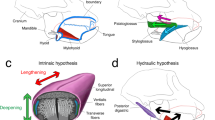Abstract
Effects of three techniques designed to improve maximum range of posterior movement of the base of tongue were investigated under videofluoroscopy in 20 subjects. Retraction of the tongue base during 3-ml pudding swallows, tongue pull-back, yawn, and gargle tasks was measured in millimeters, with the second cervical vertebra as a reference point and was judged subjectively as well. The gargle task was the most successful in eliciting most tongue base retraction for the group of subjects, although not in every subject. Gargle also resulted in greater tongue base movement than swallow more often than the other two voluntary tasks. Clinicians' subjective judgment of ``most'' retracted tongue base position was generally reliable in comparison with actual measurements. The number of repeat swallows on each bolus correlated significantly with the approximate percentage of residue in the valleculae as judged clinically.
Similar content being viewed by others
Author information
Authors and Affiliations
Rights and permissions
About this article
Cite this article
Veis, S., Logemann, J. & Colangelo, L. Effects of Three Techniques on Maximum Posterior Movement of the Tongue Base. Dysphagia 15, 142–145 (2000). https://doi.org/10.1007/s004550010016
Published:
Issue Date:
DOI: https://doi.org/10.1007/s004550010016




